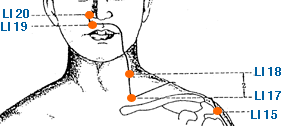LI 19
Acupuncture Point Theory
LI 19 Acupuncture Point Applications and Theory
 The acupuncture point "LI 19" , 口禾髎, is represented by "He Liao" in pinyin and "Grain Bone Hole" in english and may be found:
The acupuncture point "LI 19" , 口禾髎, is represented by "He Liao" in pinyin and "Grain Bone Hole" in english and may be found:
Directly below the lateral margin of the nostril at the level of GV 26
Of many possible clinical applications, it may be considered to influence the following issues/symptoms:
LI 19 has some precautions to be considered (see our precautions list).
Avoid Moxa (MX)
Li 19 has the following theoretical associations which serve as important guideposts in designing an effective treatment protocol:
- Intersecting point of the LI & ST Channels
A single acupuncture point is not commonly thought of as an empirical way to influence a TCM diagnostic pattern. LI19, however, is a strong candidate to be incorporated into an acupuncture protocol for patients who exhibit: Lung Wind Invasion - Wind Cold and/or Lung Wind Invasion - Wind Heat
LI 19 may potentially be used, in coordination with a well designed acupuncture treatment protocol, to influence the following conditions: Common Cold, Nasal Polyps, Nosebleed (Epistaxis), Sinus Infection and/or Sinusitis
While not necessarily valid clinically, EX Bitong (Local point for nasal issues - obstruction, conge…), EX Biyan (Local point for nasal issues - obstruction, conge…), GV 25 ( Important point to restore or help maintain c…), GV 26 (One of two Command Points (with PC 6) added to th…), GV 27 ( Problems of the mouth and sinuses - tongue ul…), ST 3 (Local point - Twitching eyelids, pain a/or swelli…) and ST 4 (Facial pain - Bell's palsy, facial paralysis, tri…) are nearby.
All Content 1999-2025
Chad J. Dupuis / Yin Yang House
Our Policies and Privacy Guidelines
Our Affiliated Clinics
